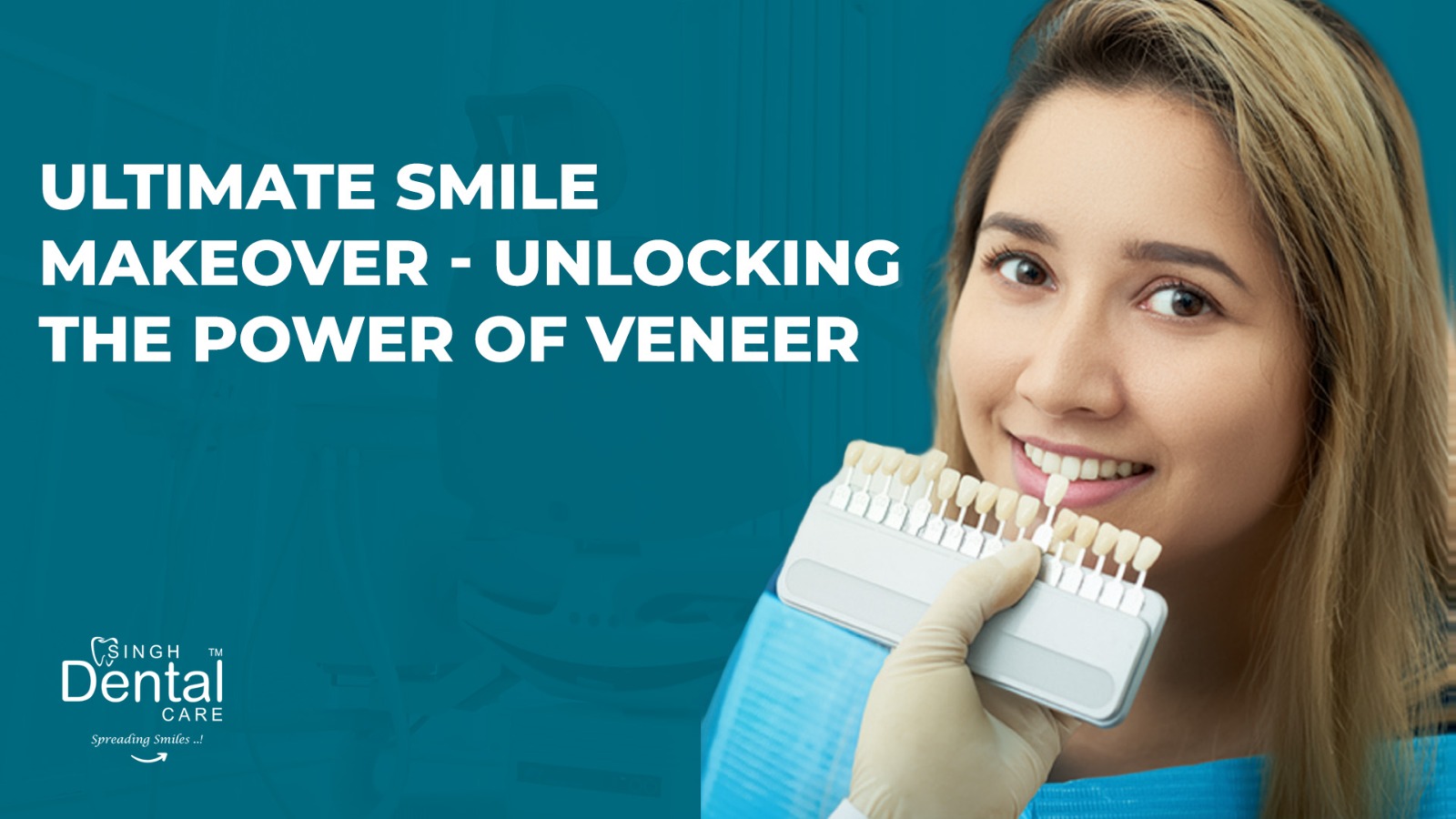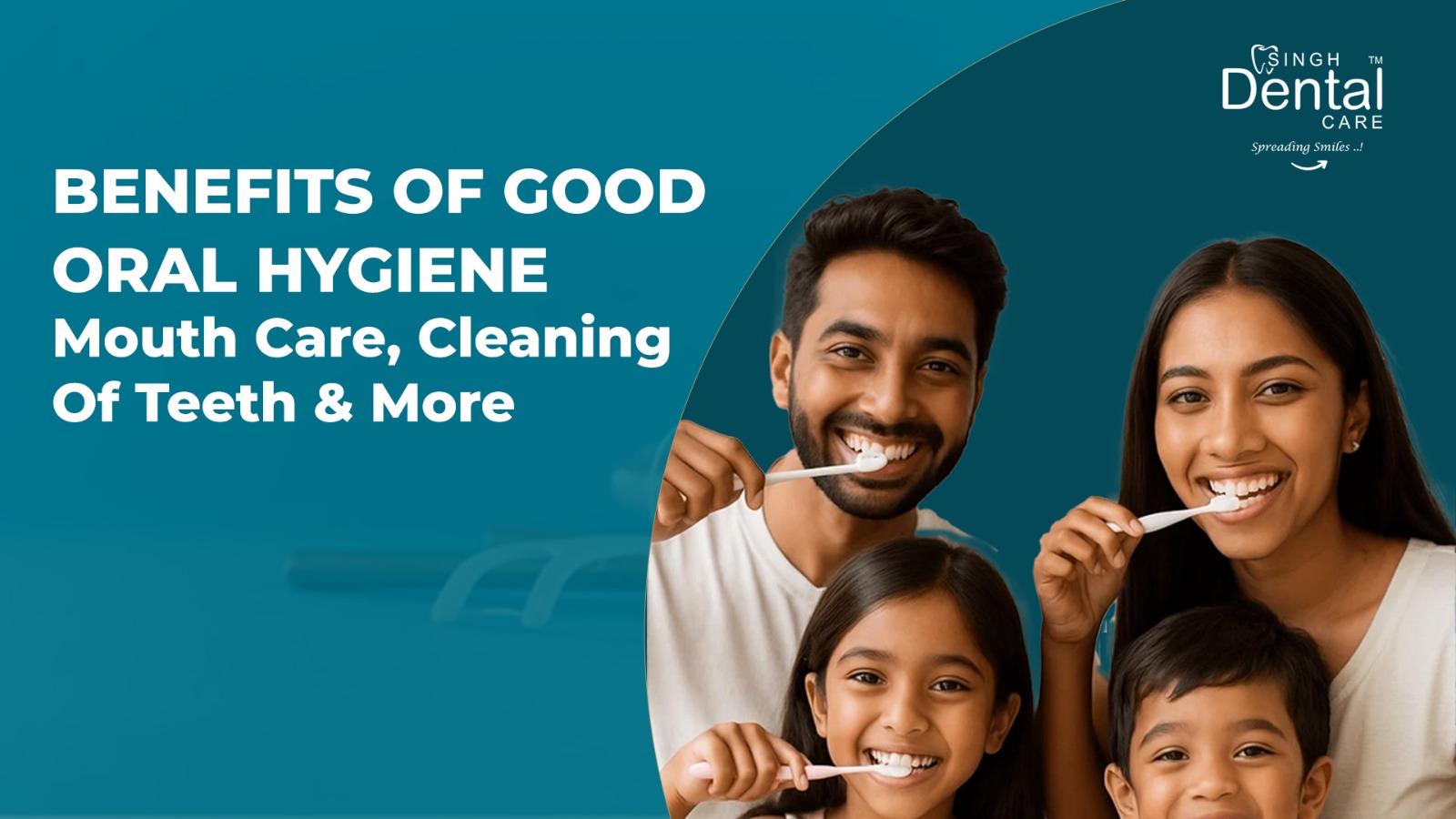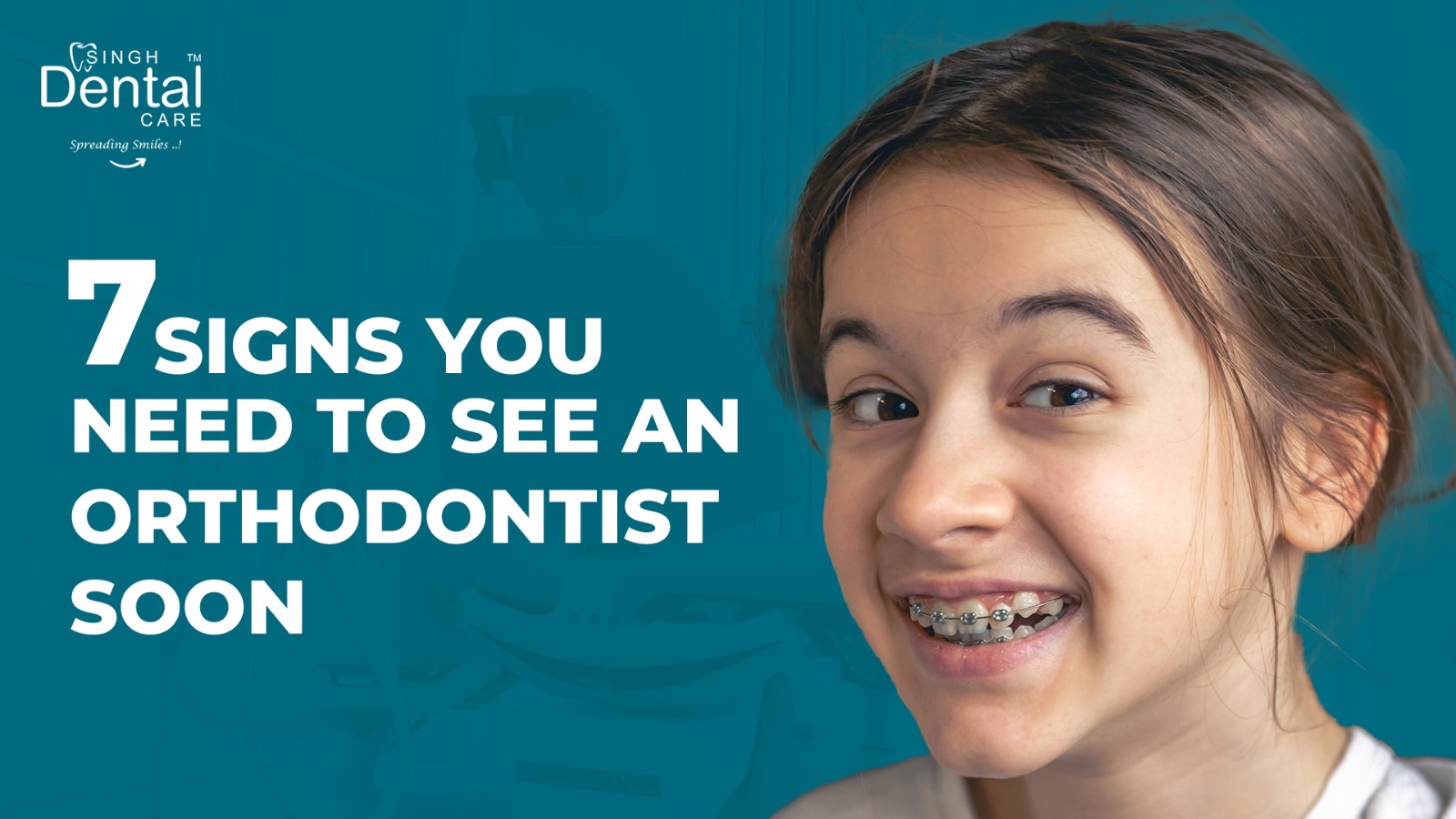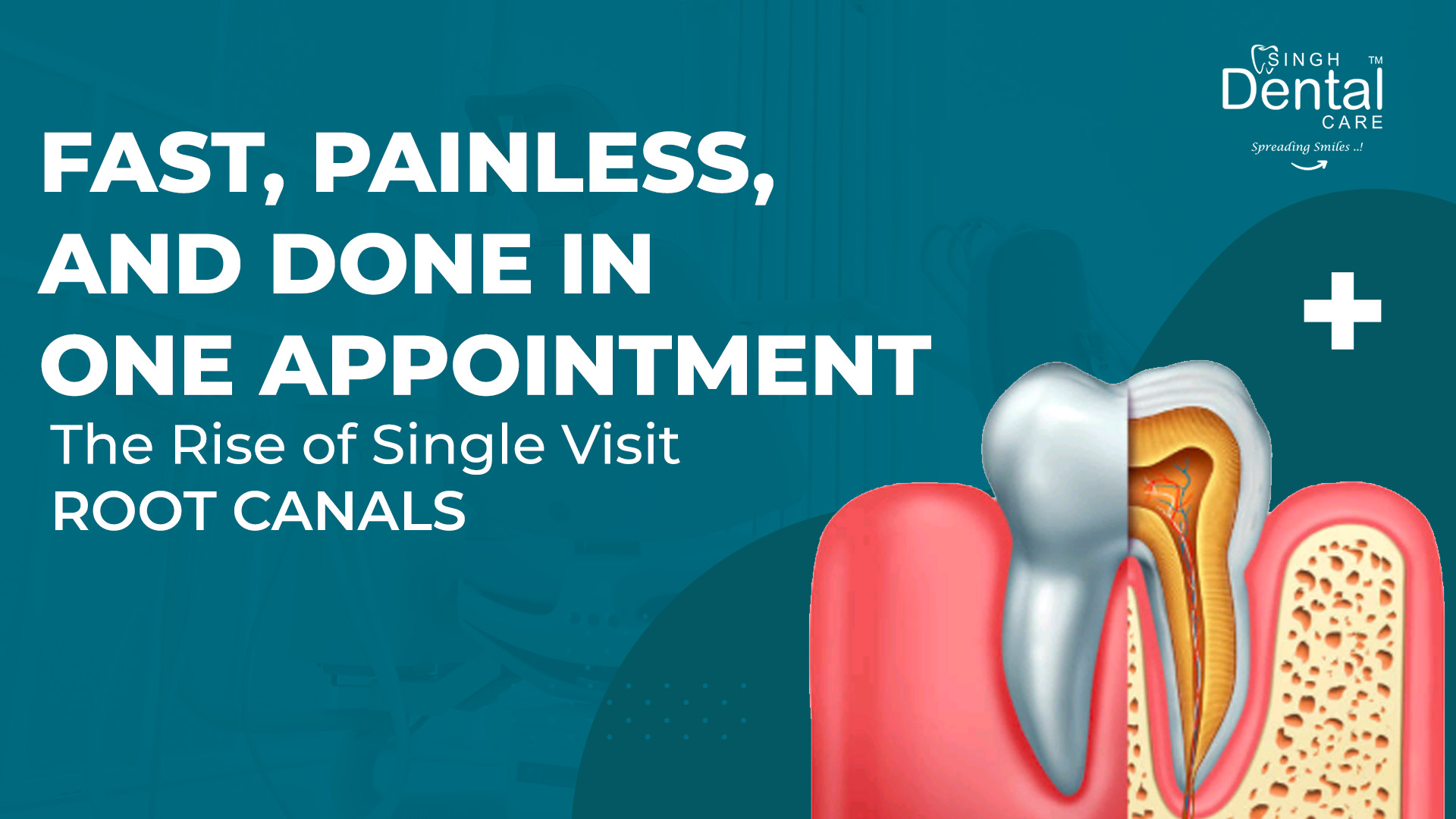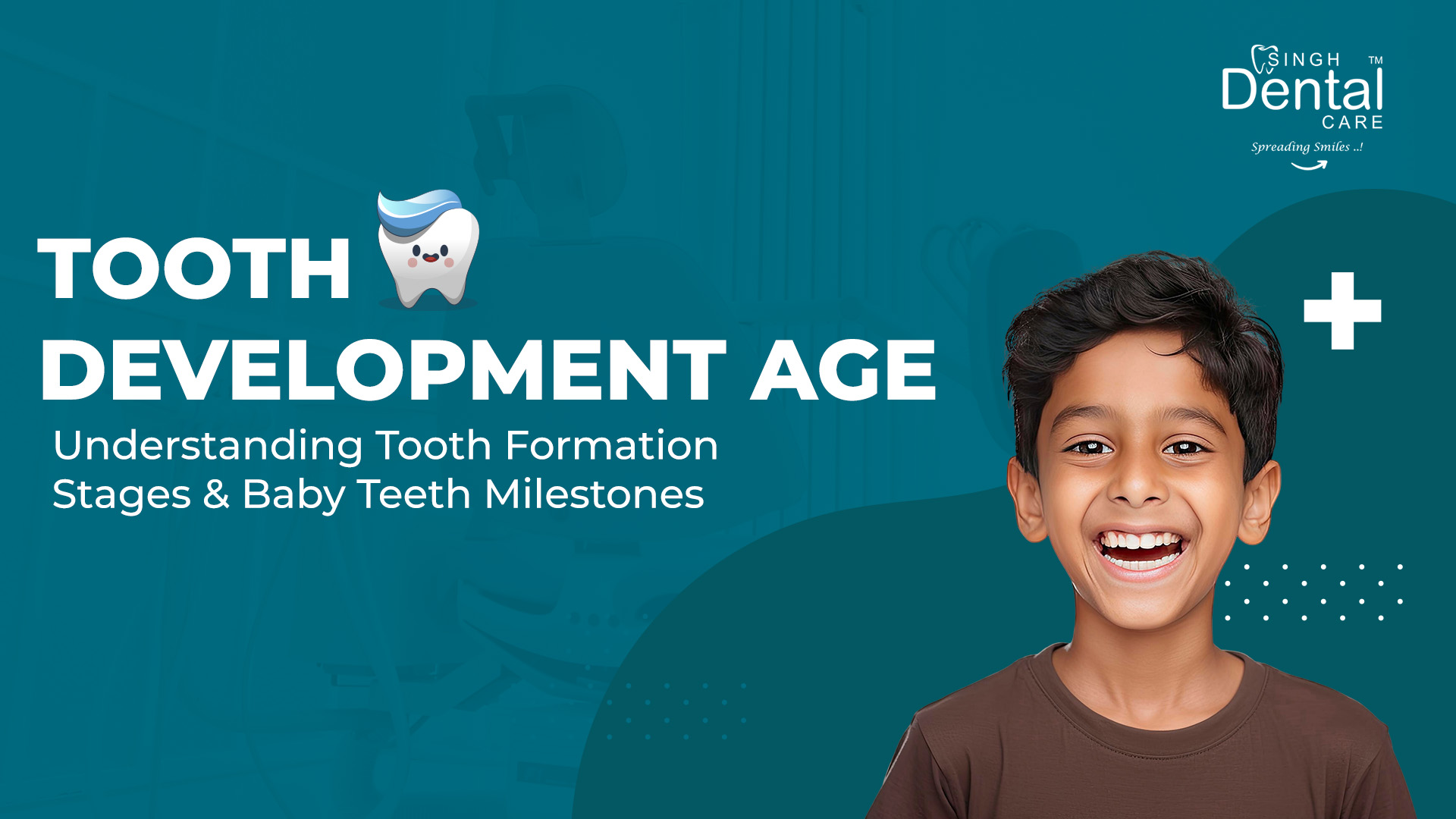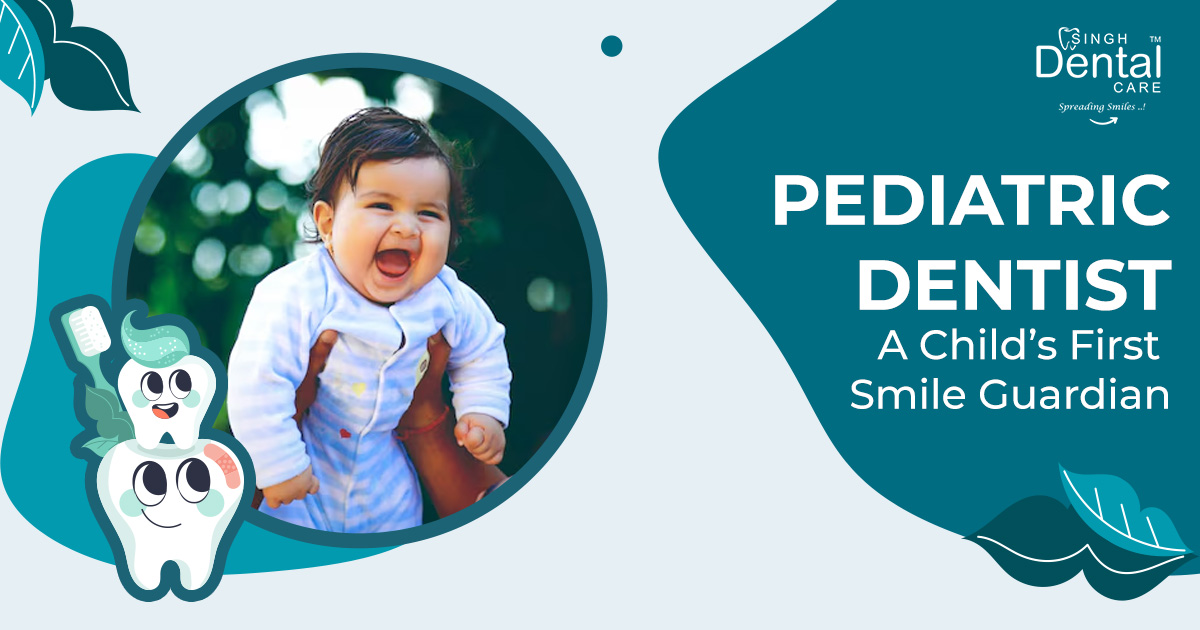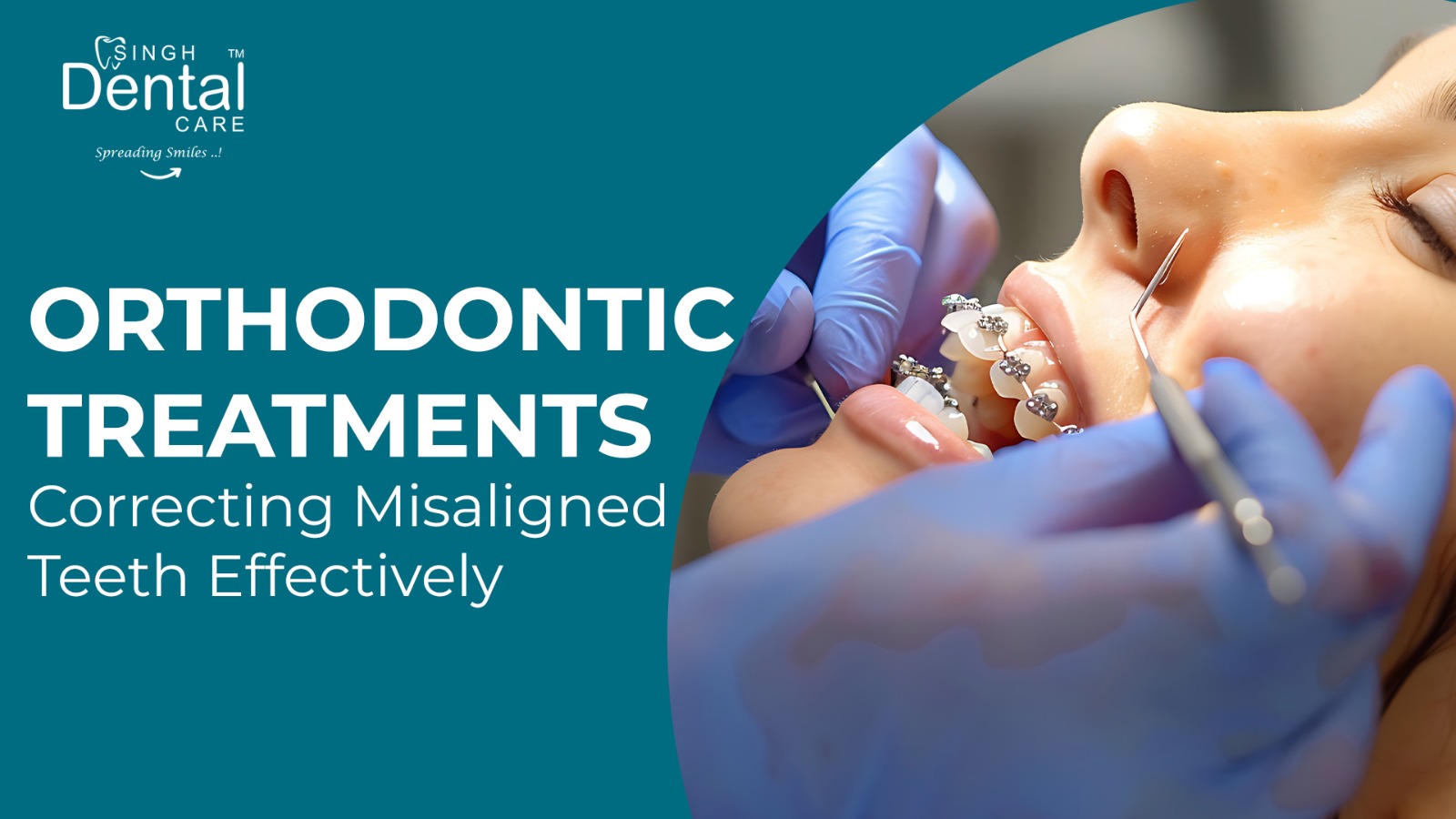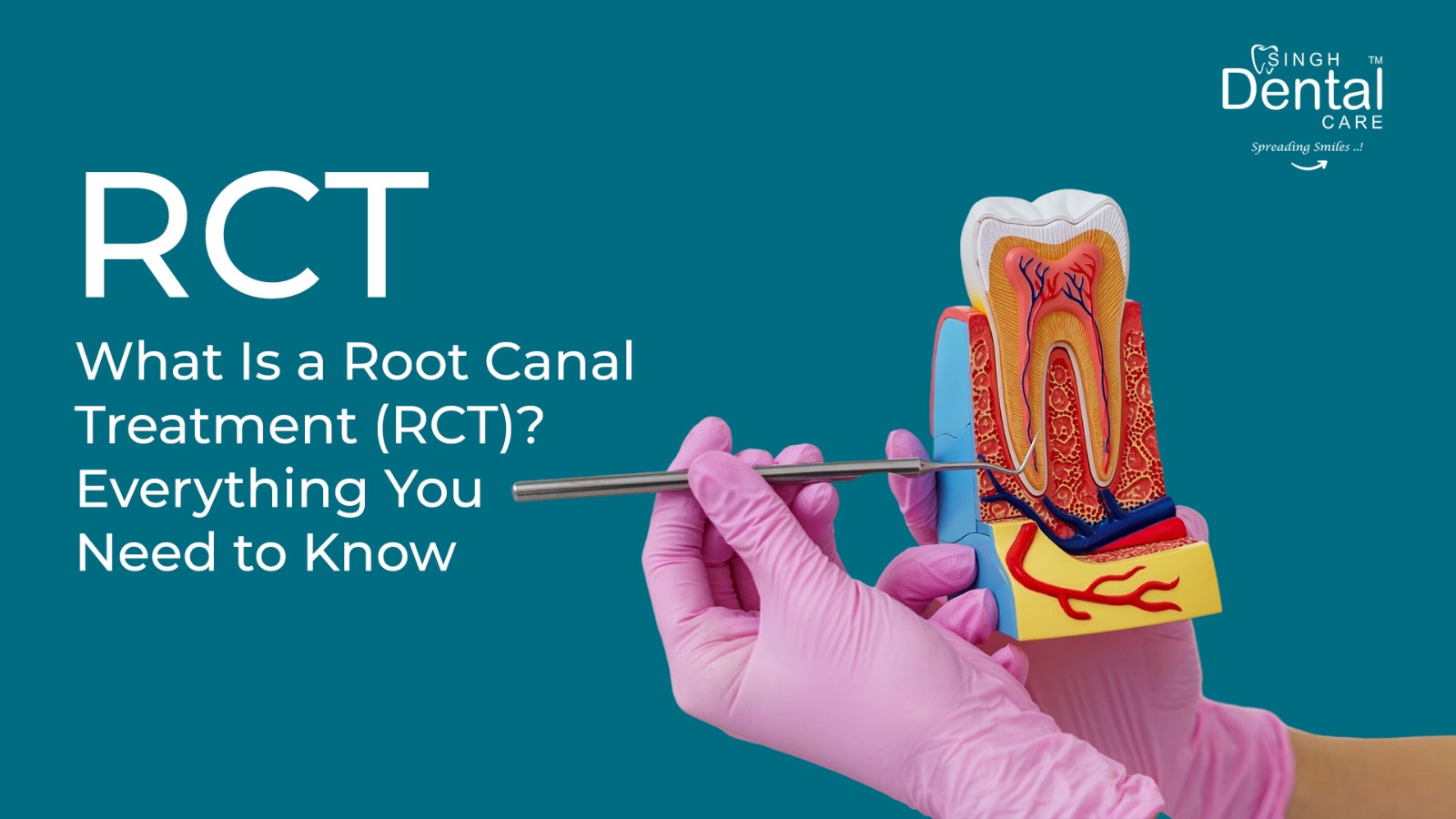At Singh Dental Care, we believe everyone deserves a confident, radiant smile. Our experienced dental team combines artistry & advanced cosmetic techniques to help you achieve your dream smile through high-quality treatment option named veneers. Discover how veneers can completely transform your smile and boost your confidence. Achieve the smile of your dreams! To improve the condition of your teeth & how they look, cosmetic dentistry blends science with the art. You can wave goodbye to the flaws, discolourations in your teeth, & any type of damage by using veneers. Use Veneers to Get the Smile of Your Dreams Veneers can improve your smile by dealing with numerous defects. Here’s how: Reshape teeth: Veneers can make the smile more symmetrical and appealing by correcting teeth if they are uneven, malformed, or oddly shaped. Resolve discolouration and stains: Veneers can hide discoloration, yellowing, or deep stains, giving you a smile that is brighter and more attractive. Restore damaged teeth to their natural appearance and stop further damage by using veneers to fix chips, cracks, & surface flaws. Reduce spaces or gaps between teeth: Veneers can reduce spaces or gaps between teeth to provide a more even and attractive smile. Enhance the appearance of crooked or rotated teeth: Veneers can make your smile more confident & aligned by correcting the defect of crooked or rotated teeth. Lengthen short teeth: Veneers can make short teeth longer, making the smile more harmonious & balanced. Brighten teeth: Veneers can transform dull and discoloured teeth to become more lively and brighter. What are Veneers? Veneers are shells that are manufactured especially for your teeth. They change your smile by fitting over the natural teeth, making the appearance more self-assured & radiant. Veneers are a common option for people looking to improve their smiles because they are made of premium materials like composite & porcelain. How Veneers Work: Custom-made: The veneer is customized to fit your particular smile and set of teeth.Smile transformation: Your smile can be transformed using veneers, which can fix a variety of flaws like gaps, chipping, and discolouration.Painless procedure: A comfortable experience is guaranteed throughout the process as it is gentle and conservative.Long-lasting effects: Veneers can give you a gorgeous smile for many years to come if you take good care of them. Are Veneers Right for You? A few factors must be taken into account when obtaining veneers:Do you clench your teeth or grind them? If so, we may need to take precautions to keep your veneers safe.Is the structure of your teeth sound? Teeth with healthy enamel are greatest candidates for veneers.What is the fit of your teeth? The success of veneers may be affected by specific biting problems. Do you have thin or little teeth? This may affect whether veneers are right for you. Choosing the Right Veneers for Your Smile Regarding veneers, you have two options: Porcelain veneers: renowned for their resilience & organic look. A durable option for brighter, self-assured smile. Porcelain veneers are customised in order to fit your teeth. Composite Veneers: These are bonded to the teeth using tooth-colored resin substance. For those looking for a less expensive yet an effective option, composite veneers are fantastic choice. The dentist can assist you in choosing the best veneer for you, as each has its own advantages. After considering the things like: Your smile objectives: With veneers, what do you hope to achieve? Your spending plan: How much budget have you planned for the treatment? Your dental requirements: How do your teeth and gums look at this moment? You can make an informed choice & get the smile that you dream by being aware of all the possibilities! The Benefits of Porcelain Veneers Considering veneers made of porcelain? The following are the benefits you should be aware of: Durability and longevity: With the appropriate maintenance, these veneers can last for 10 to 15 years or may be longer. They are incredibly sturdy while being quite thin. Natural appearance: Porcelain veneers are able to create lifelike appearance by simulating the way light falls on your teeth. Stain-resistant: Porcelain veneers have smooth surface which makes them stain-resistant, maintaining the beauty & brightness of your smile. Conservative procedure: Your teeth’s health is maintained by removing as minimal tooth structure as possible. Porcelain veneers are a popular choice for getting beautiful, long-lasting smile because of these advantages. Things to Consider About Porcelain Veneers Consider the following before considering porcelain veneers – Multiple visits: Composite veneers can be completed in one appointment. On the other hand porcelain veneers need at least two visits. Tooth preparation: In order to have the required shape with these veneers, a relatively greater amount of tooth structure may be removed. Cost: Because porcelain veneers are made in a lab, they are comparatively more expensive than composite veneers. The ability to be mended: Composite veneers can be easily fixed compared to porcelain veneers, which need replacement if chipped or damaged . Composite Veneers: Benefits and Considerations Benefits: One visit: Composite veneers can be done in a single appointment, saving you the time & avoiding the need for repeated visits. Less time: Composite veneers allow gorgeous smile with less time spent in the dentist’s chair. Enamel preservation: Composite veneers require less amount of preparation, which promotes strong bonding by protecting your original tooth enamel. Excellent initial aesthetic: Composite veneers can give you a fantastic first look that will make you smile and feel more confident. Convenient: Veneering anterior teeth with the resin composite is a practical option that has an excellent aesthetic outcome and a respectable lifespan. Disadvantages: Discoloration: Composite veneers are prone to discolouration, which can alter their appearance over years. Wear and tear: Composite veneers may need frequent maintenance or replacement due to their increased susceptibility to wear & tear. All things considered, composite veneers provide a practical & attractive way to improve your smile, but it’s important to balance both advantages & disadvantages and talk to your dentist about any
Best Foods for Having Strong Teeth – Enamel Boosters & What All to Avoid
A healthy, confident smile starts with strong teeth and enamel. While brushing is essential, your daily diet plays an equally powerful role in protecting your teeth. At Singh Dental Care (SDC), we tell our patients – ‘Let’s explore the best foods that strengthen enamel naturally, and also the foods you should avoid to keep your teeth healthy and cavity-free. Some Enamel-Boosting Foods for Having Strong Teeth 1. Dairy Products – Like Milk, Cheese & Yogurt Foods rich in calcium, phosphorus, and dairy products help rebuild tooth enamel and neutralise the acids in the mouth.Like a small cube of cheese after meals can help maintain one’s pH balance of mouth. 2. Fruits & Veggies – Like Apples and Carrots High-fiber foods act like toothbrushes , which scrub away plaque and stimulate saliva production, keeping the enamel strong.Extra chewing helps exercise jaws and improve overall circulation to gum tissues. 3. Leafy Green Vegetables – Like Spinach, Kale, Broccoli Packed with folic acid,magnesium and calcium – green leafy vegetables strengthen teeth and gums both.They are high in vitamins that help in repairing the enamel damage. 4. Nuts & Seeds Containing minerals like calcium and phosphorus, nuts help remineralize enamel.Chew a handful of almonds to boost your enamel naturally on a daily basis. 5. Fish & Eggs – For Omega-3 Fish contain vitamin D and omega-3s, which help the body absorb calcium.Egg yolks are a great source of vitamin D that support tooth formation. 6. Green Teas Rich in polyphenols, green tea fights bacteria and prevents plaque buildup.For maximum benefit, drink it without sugar to avoid damage. 7. Water Water helps wash away the acids, any food debris, and any bacteria.Fluoridated water supports enamel remineralization and prevents cavity. What Harms Your Teeth? Food Harm Sugary Drinks Erodes the enamel,causes cavities Fruits in excess High acid levels Sweets decay-causing bacteria Coffee Stain teeth Carbs sugars stick to teeth Alcohol dry mouth, reduced saliva Visit Your Nearest Singh Dental Care – Find your nearest SDC clinic visit: www.singhdentalcare.in
Benefits of Good Oral Hygiene – Mouth Care, Cleaning Of Teeth & More
Maintaining good and proper oral hygiene is more than just having a beautiful smile — it’s essential for your overall health. From preventing cavities to reducing the risk of chronic diseases, the benefits of oral hygiene go way beyond fresh breath. In this blog, we’ll explore why oral hygiene should be a part of your daily routine, the best mouth care procedures, and how regular teeth cleaning can create an impact on your long-term well-being. So What Is Oral Hygiene? Oral hygiene refers to the practice of keeping your mouth clean and free from diseases by proper brushing, proper flossing, and regularly visiting the dentist.It encompasses daily habits as well as regular professional dental check-ups. Proper oral hygiene assists in plaque removal, gum disease prevention, and in keeping strong healthy teeth. Top Benefits of Oral Hygiene 1. Prevents Tooth Decay and Gum Disease One of the best-recognized advantages of oral hygiene is the prevention of dental issues such as cavities and gum disease. Plaque is a sticky film of bacteria, builds up on your teeth and gums everyday. Brushing and flossing properly will remove this plaque and reduce the chances of developing tooth decay and formation of gingivitis. 2. Freshens Breath Poor oral hygiene often leads to bad breath often called halitosis. Regular brushing, flossing, and tongue cleaning eliminate food particles and bacteria that contribute to unpleasant odors. 3. Improves Overall Health Your oral health is a gateway to your entire body health. Poor oral health is linked to conditions like heart disease, diabetes, and respiratory infections. Keeping your mouth and oral space clean reduces harmful bacteria that can enter your bloodstream and affect your other parts of the body. 4. Saves Money on Dental Bills Preventive measures are cheaper than restorative treatments. Proper oral hygiene assists in the prevention of any expensive procedures such as root canals, crowns, or periodontal surgeries. 5. Boosts Self-Confidence and Image A healthy, bright and warm smile enhances your confidence in both social and professional situations. Individuals who maintain good oral health tend to have greater self-esteem and make a better first impression. What Should You Be Doing Daily? Following a consistent mouth care procedure ensures that you maintain optimal oral health – > Brush your teeth twice a day using a fluoride toothpaste.> Floss daily to remove any plaque or food accumulated between the teeth.> Use mouthwash to kill the bacteria and freshen your breath.> Replace your toothbrush after every 3–4 months.> Limit your sugary and acidic foods intake, which can erode the enamel.> Visit your dentist once every 6 months for proper professional cleanings. Is Teeth Cleaning Important? Professional teeth cleaning is important as it removes tartar that regular brushing can not remove. It also allows your dentist to monitor for the signs of gum disease, cavities, or oral cancer. Cleanings are quick, painless, and play a very crucial role in long-term good oral health. Conclusion – The benefits of oral hygiene reach beyond a white smile. Practicing a consistent mouth care procedure, staying on top of teeth cleaning routine, and brushing daily not only protect your teeth but also enhance the quality of life. Investing just a few minutes in a day for oral hygiene can save you from future painful procedures, expensive treatments, and many serious health complications down the line. So are you ready to improve your oral health? Start with very small changes today and enjoy the lifelong benefits of a clean, fresh and healthy smile. Find Us at Singh Dental Care – Branches > Branch 1 – Main 100 Feet Road (between Novelty Sweets & Jaycee Motors) 279, Main 100 Feet Road, East Mohan Nagar, near Novelty Sweets & Jaycee Motors > Branch 2 – B-Block Market, Ranjit Avenue (adjoining Astoria) Singh Dental Care, Inside Colour Lounge, SCO 39, B – Block > Branch 3 – Main GT Road (Opp. Khalsa College Gate No. 2) 48, Dasmesh Avenue Main GT Road, Khalsa College Rd, opposite Gate no 2, adjoining Indian Oil Petrol Pump, Amritsar, Punjab 143001 > Branch 4 – Circular Road (Near Gupta Hospital, Opp. Print & Gift) 5 AB, First Floor, Circular Road, Amritsar, Punjab 143001, India Q- What are the benefits of hygiene cleaning? A – Professional dental cleaning or hygiene cleaning is something which helps remove tartar buildup, prevent gum disease, and detect early signs of any kind of dental issues. It also leaves your teeth feeling polished and looking brighter. Q- What are the objectives of oral hygiene? A- The primary objectives of oral hygiene are to – > Prevent all dental problems like cavities and gum disease > Maintain a good and healthy oral microbiome > Maintain clean teeth and fresh breath > Support the overall health by reducing systemic inflammation caused by oral infections Q- What are the benefits of having a clean mouth and teeth? A – A clean mouth and teeth – > Reduce the risk of decay and gum disease > Improve appearance and boost your confidence > Help prevent the bad breath > Support better digestion (as oral health is the first basic step in the overall digestive process)
7 Signs You May Have to Consult an Orthodontist Shortly
Orthodontic problems tend to catch us off guard more than we’d like. What begins as a slightly off tooth or a minor bite issue can eventually become a source of pain, hygiene concerns, or even develop into confidence problems. If you are a parent observing your child’s teeth growing in, or you are an adult questioning whether that moving bite is significant—its reassuring to understand that the initial indicators that a professional’s input may be something to explore. These are 7 indications that might signal it’s time to visit an orthodontist: Teeth That Overlap, Twist, Feel Crowded When teeth don’t have proper space to rest comfortably, they will tend to overlap, turn, or appear to be packed tightly. This not only impacts the appearance but can become problematic to clean—increasing the risk for plaque, cavities, and gum disease. What to know: Straightening crowded teeth is not only a cosmetic treatment—it ensures oral health in the long run. Bite That Feels slightly “Off” – Overbite, Overjet, Underbite, or Crossbite If your upper front teeth overlap too much (overbite), your lower front teeth protrude (underbite), or a few of your teeth don’t come together correctly (crossbite), it might result in uneven wear, jaw tension, or even speech problems over time. What to know: A properly aligned bite promotes a simpler chewing, clearer enunciation, and less jaw pain. Difficulty Chewing Food Do you have difficulty biting into an apple or chewing in one side of your mouth? This could be a sign of a problem with misalignment or incorrect jaw coordination—both of which an orthodontist is qualified to assess and fix. What to know: Chewing should be easy. If it’s not, there’s usually an underlying cause worth investigating and fixing. Some Speech Sounds Are Difficult to Say Some speech problems, such as lisps or muffled sounds, can be attributed to the alignment of the teeth. While speech therapy may correct these, sometimes the cause is dental—and an interdisciplinary approach works best. What to know: Straightening teeth can enhance your speech, as well as confidence, it is most effective particularly in young children. Mouth Breathing, Particularly at Night If your child breathes through his or her mouth or snores, it might be related to how his or her jaw is growing or how his or her teeth are aligning. Small dental arches and incorrect bite placement can frequently lead to such habits. What to know: An orthodontic assessment and proper evaluation can detect problems early, potentially preventing more difficult ones later in life. Jaw Pain or Clicking Sound Problem A jaw that clicks or pops—particularly when chewing, smiling or speaking—may be a symptom of excessive stress on the jaw joints. This may be due to teeth that are not properly aligned. What to know: Orthodontic care can help relieve this tension in the jaw by improving and correcting the bite. Baby Teeth Falling Out Too Early or Too Late At the age of children, the time when baby teeth fall out determines how the adult teeth erupt. Losing baby teeth prematurely (from decay or trauma) or delayed loss (beyond the normal time) can lead to crowding or misalignment of the permanent teeth. What to know: Early orthodontic examination—are usually suggested by the age of 7— this can track and direct normal development. Orthodontic Care is All About Early Prevention, Not Necessarily Appearance or How You Look Most individuals believe braces or aligners are simply about straightening teeth to get a better smile or more aesthetically pleasing appearance. In fact, they usually prevent more severe issues—from initial tooth wear to gum issues and aching jaws. Consulting an orthodontist does not necessarily mean that you will have braces immediately. Quite the opposite, for children, early observation tends to preclude more involved treatments later on. For adults, newer alternatives such as clear aligners have made it simpler and less noticeable to enhance alignment at any given age. Do You Need Expert Orthodontic Advice? If any of these signs sound familiar to you, it’s worth seeking a consultation with a qualified orthodontist near you. Across India, many multi-specialty dental clinics now offer advanced tools like 3D scanning and personalized aligner plans—making orthodontic care more accessible and comfortable than ever before. At dental clinics such as Singh Dental Care, you will get a team that is familiar with dealing with both uncomplicated and complicated orthodontic cases, with the support of top-class technology and patient-centered treatment. Real Experiences of Real Patients “My daughter had teeth crowding, and we were concerned about her smile. The orthodontist told us everything in detail, and the process has been easy.” — Parent from Delhi “I never thought adults needed braces, but I was mistaken. Clear aligners corrected an established bite problem.” — Rajesh, 34, Mumbai So What’s Next? If you’re wondering if you or your child might benefit from orthodontic care, begin by watching the daily routines—such as chewing, talking, smiling, breathing, and general jaw movement. You don’t have to wait for pain or obvious issues to contact us. Tip – Get a visit to an orthodontist at age 7 for kids, and whenever you experience changes in bite or alignment as an adult.
Fast, Painless, and Done in One appointment: The Rise of Single Visit Root Canals
Fast, Painless, and Done in One appointment: The Rise of Single Visit Root Canals Let’s be honest—no one ever looks forward to a root canal. The words alone are enough to scare us. But what if I tell you that root canal treatments in 2025 are now faster, more comfortable, and often completed in just one visit? Welcome to the world of single visit root canals—where what used to take several appointments can now be handled in only ONE visit. Let us dive into the depths of this concept. What Is a Single Visit Root Canal? Traditionally, a root canal meant at least 2–3 visits, spaced out over a week or two. Each session involved cleaning out infected pulp, medicating the canal, and eventually sealing the tooth. This dragged-out timeline wasn’t just inconvenient—it left the tooth vulnerable between sessions. But now, with modern tools, imaging systems, and techniques, many root canals can be safely and effectively completed in just one sitting. Think of it like fast-track dentistry—minus the pain, plus precision. The Science Behind the Speed From Dreaded to Done: What Changed? Now its a combination of technology and technique: Rotary Endodontics: Advanced tools that clean canals faster and more thoroughly than traditional hand files. Apex Locators: Devices that identify the precise end of the root, thus improving accuracy. Digital X-rays and 3D Imaging: Real-time visuals that help dentists map every twist and turn of your root canals. High-Performance Filling Materials: Seal the tooth instantly, leaving no room for reinfection. Dental microscopes – When we can see something clearly, we can treat it more effectively. Dental microscope leads to better visibility for deep cleaning and accurate sealing. With these in place, dentists no longer need multiple sessions—they can diagnose, disinfect, and restore your tooth then and there. Why Dental Patients Are Loving It?? 1.Time-Saving That said, most general cases today can be done in one session—and dentists trained in modern endodontic methods are leading this shift. Final Word: Believe in the MAGIC of single visit root canals The magic of single visit root canals isn’t just in the technology—it’s in the experience. It’s about giving you back your comfort, your time, and your smile… in one visit. If you’ve been avoiding the dentist because you fear a long, painful process—think again. With modern dentistry, a root canal can be just as easy as getting a filling. At Singh Dental Care, we are committed to delivering painless, affordable, and transparent dental treatments. Our clinics are equipped with cutting-edge technology and use only the best materials to deliver world-class results. What truly sets us apart? We’re a multispecialty dental chain, which means every treatment is handled by the right expert. When it comes to root canal treatments, you’re in the hands of a skilled Endodontist—a specialist trained specifically in saving teeth with precision and care. This ensures faster healing, maximum comfort, and long-term success—all at a price that’s easy on your wallet. So next time you hear someone complain about needing a root canal, you can say, “It’s not what it used to be. You’ll be in and out before you know it.” Dr. Deepali Sandhu (M.D.S. Conservative Dentistry and Endodontics)
Tooth Development Age: Understanding Tooth Formation Stages & Baby Teeth Milestones
Tooth Development Age: Understanding Tooth Formation Stages & Baby Teeth Milestones Ever spotted that first tiny tooth peeking out of your baby’s gummy smile and thought, “Wow, it’s happening!”? Tooth development might not be the loudest milestone, but it marks the beginning of an essential journey in your child’s development—and one of the most Googled by new parents. Let’s take a fun, friendly walk through the timeline of toothy transformations: from those secret behind-the-scenes tooth formation stages to the big, bold arrival of baby teeth. Understanding the tooth development age and the various tooth formation stages can help parents navigate this exciting phase with confidence. What Is Tooth Development Age? Think of tooth development age as your baby’s dental growth timeline. It’s not just about when the teeth form and emerge—it’s the whole journey. Right from their time in the womb, your baby’s teeth are secretly forming beneath the surface. For most babies, the first tooth shows up around 6 months—but “normal” is a wide range. Some show up at 4 months, others take their sweet time until after their first birthday. The 5 Tooth Formation Stages (What’s Happening Under the Gums?) Before that pearly white appears, there are five distinct stages that it goes through: Initiation StageAround 6–7 weeks of pregnancy, your baby’s mouth starts setting the foundation for future teeth. It’s like the dental blueprint phase. Bud StageBetween the 8th and 9th weeks, tiny “buds” form under the gums, indicating the initial growth of teeth. Cap StageBy the 9th or 10th week, these buds start developing shape cap-like structure—kind of like putting a helmet on the forming tooth. Bell StageThis is the detailing phase. It involves the differentiation of cells that will form the various parts of the tooth. Maturation Stage (Late-Bell Stage)This is the final phase where the tooth’s hard tissues fully develop, preparing for eruption. The tooth starts calcifying and gets ready to make its debut. These tooth formation stages are happening even before teething starts. So while your baby’s gummy grin is stealing hearts, their mouth is quietly busy behind the scenes. Baby Teeth Stages: Eruption Timeline Typically, a child’s first tooth appears between 6 and 10 months of age—usually the bottom front ones (central incisors). However, this can vary, with some infants teething as early as 3 months or as late as 12 months. Here’s a quick peek at the baby teeth timeline: Tooth Type Eruption Age (Months) Bottom front (central incisors) 6–10 months Top front (central incisors) 8–12 months Side incisors 9–13 months First molars 13–19 months Canines (cuspids) 16–22 months Second molars 23–33 months By age 3, most toddlers have a full set of 20 baby teeth—and know exactly how to use them on snacks and spoons. At what age are teeth fully developed? Primary (baby) teeth are usually all in by age 3. Permanent teeth begin to emerge around age 6 and continue into early adulthood, with wisdom teeth appearing between ages 17 and 21. What are the 5 stages of tooth development? Quick refresher: 1. Initiation 2. Bud 3. Cap 4. Bell 5. Late-bell stage Think of it as your baby’s first dental construction project—carefully laid out and beautifully executed. Is it normal for a 7-month-old to not have teeth? Totally normal. Some babies are early bloomers; others take their time. Some even skip the baby teeth party until 12+ months. No rush—they all get there! At what age does a child develop teeth? Teeth form in the womb, but visible eruption usually starts around 6 months. Most kids are in full baby-tooth mode by 3 years. Taking Care of Tiny Teeth (Even Before They Show Up!) To keep things healthy from the start: Before teeth erupt: Wipe baby’s gums with a clean, damp cloth. First tooth appears? Time to bring out a baby toothbrush (soft bristles only). Use fluoride-free toothpaste (unless your dentist suggests otherwise). First dental visit: Book it by your baby’s 1st birthday—even if there’s just one lonely little tooth! A pediatric dentist can guide you through it all—from teething tips to long-term tooth care. Final Thoughts: From Gummy Smiles to Gorgeous Grins The tooth development age is a wild ride—from silent, in-womb beginnings to that proud first grin with tiny teeth. Every baby follows their own rhythm, and every new tooth is worth celebrating (even if it comes with a bit of drool and crankiness). Keep brushing, keep smiling, and remember: You’re doing a great job, tooth fairy-in-training. Dr Navneet Kaur
Pediatric Dentist: A Child’s First Smile Guardian
Pediatric Dentist: A Child’s First Smile Guardian A child’s smile is precious- bright, innocent and full of joy. There is nothing more heartwarming than your child’s very first toothy grin, and ensuring its health is a priority for parents. Behind every beaming grin is a journey of oral development that needs love, attention, and expert care. At the heart of this beautiful journey stands a pediatric dentist—a dedicated professional trained to protect, guide, and nurture your child’s oral health every step of the way. From baby teeth to braces, a pediatric dentist is more than just cavity fixers. They play a vital role in shaping your child’s dental future, making sure their journey from gummy giggles to confident smiles is smooth, healthy, and tear-free (well, mostly). What is Pediatric Dentistry? Before we dive in, let’s begin with the pediatric dentistry definition. Pediatric dentistry is a dental specialty that on the oral health of infants, children, adolescents, and children with special needs. It goes beyond cleaning teeth—it includes behaviour management, growth tracking, preventive care, and habit counselling, and therapeutic interventions specifically tailored to the physical and psychological development of children at all different stages. Simply put:Pediatric dentistry = Big care for little teeth. Unlike general dentists, a pediatric dentist is specially trained to care for children through every stage of development—emotionally and physically. Their goal? To build trust, reduce fear, and create positive dental experiences, growth and development, trauma management, sedation techniques, and communication strategies that ease dental anxiety. A pediatric dentist understands how to manage teething toddlers, restless school-goers, and anxious teens—all with compassion. It’s not just about cleaning and fixing teeth. It’s about understanding a child’s unique physical and emotional development, and creating care that fits just right. Pediatric dentists: Teach kids how to brush like a boss Catch problems early (like bite issues or thumb sucking) Make dentist visits fun instead of scary Work with kids who have special healthcare needs Helping parents support healthy routines at home Who Is a Pediatric Dentist? A pediatric dentist is a dental professional who undergoes additional training after dental school to focus exclusively on child oral care. Their expertise lies not only in treating cavities but also in early detection of dental issues, habit counseling, trauma management, and creating a dental-friendly experience. They’re the smile protectors, tooth teachers, and emotional supporters of little ones in the dental chair. Pediatric dentists: Monitor oral growth Treat cavities and injuries Guide erupting teeth Provide habit-breaking advice (like thumb sucking) Work closely with parents on prevention They know how to: Calm a nervous toddler Explain flossing in a way a 5-year-old will actually get Work with teens without triggering eye-rolls Fun Fact: Pediatric dentists are trained to turn dental visits into positive, even exciting, adventures for extra-sassy little ones. Other Names for a Pediatric Dentist ? You might also come across: Pedodontist (especially in the U.S. and India) Paedodontist (used in the UK and some parts of India) They’re all terms for a certified pediatric dentist trained to treat children’s oral health needs. Same job, same skills—just different spelling. Tomato, tomahto. Why Pediatric Dentists Matter The need for pediatric dentists is greater than ever before. According to the CDC, tooth decay is the most common chronic childhood disease—five times more common than asthma. Left untreated, dental problems can interfere with eating, speaking, learning, and overall development. Around 51% of children aged 6-11 years have cavities and 1 in every 10 children suffers from dental pain making it hard to chew and eat healthy foods. Pediatric dentists are key to: Preventing early childhood caries Promoting proper brushing and flossing Encouraging regular dental checkups Offering fluoride and sealant applications Their clinics are designed with children in mind—colorful walls, smaller dental chairs, and a welcoming environment that turns fear into fun They also emphasize preventive dentistry, using tools like: Topical fluoride applications (like vitamins for teeth) Dental sealants (tiny shields for molars) Early orthodontic assessments Nutrition and hygiene counselling for parents and kids And yep—they treat cavities, trauma, and teething tantrums too. When should you visit a Pediatric Dentist? More often than not, parents are referred to a pediatric dentist when their child’s tooth trouble is out of hand and may require invasive treatments. While a Pediatric dentist is well equipped to manage them as well, there are ways offered by contemporary dentistry which can prevent those problems from ever happening in the first place. Early dental visits build trust and lay the foundation for lifelong oral health. Keep in mind the Rule of 7 in Pediatric Dentistry: 7 months: First tooth erupts 7 years: First permanent molars arrive 17 years: All adult teeth are usually in place (except wisdom teeth) A good pediatric dentist ensures that every milestone is monitored and supported. What Happens at a Child’s First Dental Visit? The AAPD recommends that a child should visit a dentist by age 1 or within 6 months of the eruption of the first tooth—whichever comes first. A child’s first dental visit with a pediatric dentist should be easy-going, positive, and educational. The goals: Familiarize the child with the dental clinic Teach parents about brushing and diet Identify potential issues early Pediatric dentists often use play-based communication, puppets, or storybooks to explain procedures. This builds a strong, trusting relationship that grows with the child. Tip: Make the first visit fun. Choose a morning appointment when the child is well-rested and avoid using words like “pain” or “hurt.” What Does “Paedodontic” Mean? It’s just a fancy word for pediatric dental care. Paedo = child Odontic = teeth Together, paedodontics means “child’s dental science”—the art and science a pediatric dentist practices every day. Pediatric Dentists vs. General Dentists Yes, general dentists can treat kids… but pediatric dentists are the true pros at it. Here’s why: Feature General Dentist Pediatric Dentist Patient age All ages Kids only Training Basic dental degree (5 years) Basic dental degree (5 years) + 3 years specialized training Clinic setup Adult-oriented
Orthodontic Treatments: Correcting Misaligned Teeth Effectively
Orthodontic Treatments: Correcting Misaligned Teeth Effectively April 4, 2025 Achieving a straight, healthy smile is about more than just aesthetics—properly aligned teeth improve oral health, making it easier to clean your teeth, reducing the risk of cavities, gum disease, and even improving your bite. If you’re considering orthodontic treatment to align your teeth, you’re not alone. Millions of people each year undergo orthodontic treatments to correct dental issues such as crooked teeth, misalignment, gaps, overbites, underbites, and more. In this blog, we’ll explore the different types of orthodontic treatments available today, helping you understand the options and find the best solution for your smile. What Is Orthodontic Treatment? Orthodontic treatment involves the use of dental appliances, such as braces or aligners, to correct the alignment of the teeth and jaw. The goal is to straighten teeth, close gaps, correct bite problems, and improve the overall functionality and appearance of your smile. Orthodontic treatments are commonly used to treat problems like: • Crowded teeth (when teeth overlap) • Gaps between teeth • Overbite (when the upper teeth overlap the lower teeth too much) • Underbite (when the lower teeth extend past the upper teeth) • Crossbite (when teeth on one side of the mouth don’t align properly) • Open bite (when the upper and lower teeth don’t meet when the mouth is closed) Depending on the severity of the issue, the type of treatment will vary. Let’s take a closer look at the various orthodontic treatments available. 1. Traditional Metal Braces Traditional metal braces are the most well-known and widely used orthodontic appliance. They consist of metal brackets attached to the teeth, connected by a metal wire, which applies pressure to move the teeth into their correct positions over time. Key Features: • Brackets: Small metal squares that are bonded to the front of the teeth. • Wire: A metal wire that is threaded through the brackets and adjusted to apply pressure. • Rubber bands: Often used in conjunction with braces to correct bite issues and improve alignment. Pros: • Highly effective for treating a wide range of alignment issues, including complex cases. • Suitable for all ages—teens and adults alike. • Affordable and widely available. Cons: • Visible and may be less aesthetically appealing. • Can cause discomfort due to adjustments. • Requires more frequent visits to the orthodontist for adjustments. 2. Ceramic Braces Ceramic braces are similar to traditional metal braces in terms of function but differ in appearance. These braces use clear or tooth-colored brackets, making them less noticeable than metal braces. The wire is typically made of metal, but it is sometimes coated in a tooth-colored material to blend in with the teeth. Key Features: • Clear/Tooth-Colored Brackets: These are less visible and blend with your natural tooth color. • Metal or Clear Wire: The wire used in ceramic braces may be less noticeable than the traditional metal wire. Pros: • Less noticeable than metal braces, making them a more discreet option. • Effective for treating most orthodontic issues, including moderate to severe misalignments. • Suitable for teens and adults who are concerned about appearance. Cons: • More expensive than metal braces. • Brackets may be more prone to staining if not cared for properly. • Can be bulkier and may require more frequent adjustments than metal braces. 3. Lingual Braces Lingual braces are similar to traditional braces but are placed behind the teeth, making them virtually invisible from the outside. They are a great option for people who want the benefits of braces without the visibility of traditional metal or ceramic braces. Key Features: • Hidden Placement: The brackets are attached to the back of the teeth, making them completely out of sight. • Custom-Made: Each set of lingual braces is custom-designed to fit your mouth. Pros: • Completely invisible from the outside, making them ideal for people who don’t want anyone to know they’re undergoing orthodontic treatment. • Effective for treating most orthodontic issues, including complex cases. • Suitable for adults who are concerned about aesthetics. Cons: • More expensive than traditional braces. • May be more uncomfortable at first, especially when it comes to speech and tongue movement. • Requires more maintenance and frequent visits for adjustments. • Harder to clean compared to traditional braces. 4. Clear Aligners (e.g., Invisalign) Clear aligners, such as Invisalign, are a popular alternative to traditional braces. These are custom-made, clear plastic trays that fit over your teeth and gradually shift them into the desired position. They are removable, which makes them a convenient option for those who want to straighten their teeth without the commitment of permanent appliances. Key Features: • Clear, Removable Trays: Aligners are virtually invisible and can be removed for eating, drinking, and cleaning. • No Metal Components: There are no brackets or wires involved. • Custom Treatment Plan: A series of aligners is created based on 3D imaging of your teeth and treatment goals. Pros: • Discreet: The clear plastic is nearly invisible, making them a great option for adults and teens who want to avoid the appearance of braces. • Removable: You can take the aligners out to eat, drink, brush, and floss, which makes maintaining good oral hygiene easier. • Comfortable: Aligners are made from smooth plastic, which is more comfortable than traditional braces, with no metal to irritate your mouth. • Fewer Office Visits: Typically, you’ll only need to visit the orthodontist every 6-8 weeks for monitoring and new aligners. Cons: • Requires discipline to wear aligners for 20 to 22 hours a day. Skipping wear time can delay treatment progress. • Not suitable for all orthodontic issues. Complex cases may require traditional braces. • May require additional costs for retainers after the treatment. 5. Self-Ligating Braces Self-ligating braces are similar to traditional braces but with a unique twist. They use a sliding mechanism instead of elastic bands to hold the wire in place, which helps reduce friction and make the braces more efficient at moving teeth. Key Features:
Wisdom tooth surgery : Everything You Need to Know About Wisdom Tooth Surgery
Wisdom tooth surgery : Everything You Need to Know About Wisdom Tooth Surgery April 4, 2025 Wisdom teeth are the last set of molars at the back of your mouth. These teeth typically emerge between the ages of 17 and 25, and while some people experience no problems with their wisdom teeth, others may face complications that require wisdom tooth surgery. If you’re experiencing pain, swelling, or discomfort due to your wisdom teeth, surgery may be the recommended solution. In this blog, we’ll cover everything you need to know about wisdom tooth surgery, from what the procedure entails to recovery tips and why it may be necessary. What Are Wisdom Teeth? Wisdom teeth are the third set of molars located at the back of your mouth. Most people have four wisdom teeth, one in each corner of the mouth (upper right, upper left, lower right, lower left). These teeth were useful to our ancestors for grinding and chewing plant matter, but as diets and jaw sizes have evolved, these teeth are no longer as necessary for modern human diets. For many people, wisdom teeth cause no issues and come in without complications. However, in other cases, the wisdom teeth may not have enough space to emerge properly or can become impacted, leading to pain, swelling, or other dental problems. Why Do You Need Wisdom Tooth Surgery? Not everyone needs to have their wisdom teeth removed, but there are several common reasons why your dentist or oral surgeon may recommend wisdom tooth surgery: 1. Impacted Wisdom Teeth: When a wisdom tooth doesn’t have enough room to emerge fully or comes in at an awkward angle, it can become impacted. Impacted teeth can cause pain, infection, or damage to nearby teeth. 2. Infection or Gum Disease: If a wisdom tooth partially emerges through the gum, it can create a flap of gum tissue that traps food and bacteria, leading to infections, bad breath, and gum disease. 3. Cavities or Tooth Decay: Wisdom teeth are harder to clean due to their location at the back of the mouth. If a wisdom tooth becomes decayed or develops cavities, it may require extraction. 4. Crowding or Misalignment: If your wisdom teeth push against your other teeth, they can cause overcrowding, leading to misalignment of your bite or discomfort in the jaw. 5. Cysts or Tumors: In rare cases, wisdom teeth can develop cysts or tumors around the tooth, leading to potential damage to the jawbone and surrounding teeth. If you’re experiencing pain, swelling, or difficulty fully opening your mouth, it’s important to visit a dentist or oral surgeon to assess whether wisdom tooth surgery is necessary. What Does Wisdom Tooth Surgery Involve? Wisdom tooth surgery is a relatively common procedure, but the specifics of the surgery can vary based on factors such as the number of teeth being removed, their position, and the complexity of the extraction. Here’s what you can expect during the procedure: 1. Consultation and Evaluation Before surgery, your dentist or oral surgeon will take X-rays to examine the position of your wisdom teeth and evaluate the condition of your gums and jaw. This helps them create a customized treatment plan for your extraction. 2. Anesthesia Options Wisdom tooth surgery is usually performed under one of the following types of anesthesia: • Local Anesthesia: Numbs the area around the wisdom tooth to prevent pain during the procedure. You will be awake, but you won’t feel any discomfort. • Sedation Anesthesia: Involves a sedative to help you relax while local anesthesia is used to numb the area. You will be awake but in a drowsy state. • General Anesthesia: Involves being fully unconscious during the procedure. This option is often used for more complicated extractions or for patients who are particularly anxious. 3. The Extraction Process The surgery itself involves the following steps: • Incision: The oral surgeon will make an incision in the gum tissue to access the tooth or teeth. • Removal of the Tooth: If the tooth has fully emerged, it will be removed. If the tooth is impacted or partially erupted, it may need to be broken into smaller pieces for easier removal. • Cleaning and Stitching: After the tooth is removed, the area is cleaned to remove any debris. The incision is typically closed with stitches, which may dissolve on their own over time. 4. Post-Operative Care After surgery, your dentist or oral surgeon will provide instructions on how to care for your mouth as it heals. This may include pain management, care for the surgical site, and advice on eating and drinking during recovery. Recovery After Wisdom Tooth Surgery Recovery from wisdom tooth surgery usually takes a few days to a week, depending on the complexity of the extraction and how many teeth are removed. Here’s what you can expect during your recovery: 1. Swelling and Bruising Swelling around the jaw and face is common after wisdom tooth surgery. Ice packs can help reduce swelling and discomfort, and bruising may also occur. Most swelling peaks within the first 48 hours and then starts to subside. 2. Pain Management Mild to moderate pain is normal after wisdom tooth surgery. Your oral surgeon will prescribe pain medications to help manage discomfort. Over-the-counter pain relievers, such as ibuprofen or acetaminophen, may also help. 3. Bleeding Some bleeding is normal right after surgery, but it should gradually decrease. You may be asked to bite down on gauze to help control the bleeding and apply pressure. 4. Dietary Restrictions For the first few days after surgery, you’ll need to stick to a soft food diet and avoid hot, hard, or spicy foods that could irritate the surgical site. Foods like mashed potatoes, yogurt, soup, and smoothies are good options. 5. Oral Hygiene It’s important to keep your mouth clean to prevent infection, but you should avoid brushing the extraction sites for a few days. After that, you can gently brush your teeth, avoiding the surgical area. Your dentist may recommend
Dental Aligners :Everything You Need to Know About Dental Aligners
Dental Aligners :Everything You Need to Know About Dental Aligners November 27, 2024 In the world of modern orthodontics, dental aligners have revolutionized the way people straighten their teeth. Offering a discreet, comfortable, and convenient alternative to traditional metal braces, dental aligners have become a popular choice for both teens and adults seeking to improve their smile. If you’re considering aligners, it’s essential to understand how they work, their benefits, and what to expect during treatment. In this blog, we’ll cover everything you need to know about dental aligners. What Are Dental Aligners? Dental aligners are clear, custom-made trays designed to fit over your teeth and gradually shift them into better alignment. Made from plastic or a flexible thermoplastic material, aligners are nearly invisible, making them an attractive option for people who want to straighten their teeth without the aesthetic concerns of traditional metal braces. Aligners are a part of orthodontic treatment that helps move teeth into more favorable positions, improving both function and appearance. How Do Dental Aligners Work? Dental aligners work by applying gentle pressure to your teeth, gradually shifting them into their proper positions. Here’s how the process works: 1. Initial Consultation and Assessment: You begin by visiting your dentist or orthodontist for a consultation. They will assess your teeth, take X-rays, and may use 3D scanning or impressions to create a detailed digital map of your mouth. This helps design a custom treatment plan that maps out how your teeth will move over time. 2. Custom-Fit Aligners: Based on the digital impressions, a series of custom aligners are created for your teeth. Each set of aligners is worn for a specific period—typically 1-2 weeks—before being replaced with the next set in the series. These aligners will gradually move your teeth into the desired position. 3. Gradual Tooth Movement: With each new set of aligners, your teeth will slowly shift according to your treatment plan. Aligners apply gentle pressure, and each set of aligners is designed to move your teeth step-by-step until the final desired alignment is achieved. 4. Follow-Up Appointments: Periodic visits to your dentist or orthodontist will be scheduled to monitor progress and make any necessary adjustments to ensure that your teeth are moving correctly. Depending on your treatment plan, adjustments to your aligners may be needed. Benefits of Dental Aligners Dental aligners offer several advantages over traditional metal braces, making them an increasingly popular option for orthodontic treatment. Here are some of the key benefits: 1. Aesthetic Appeal The most obvious benefit of dental aligners is their discreet appearance. Made of clear plastic, aligners are virtually invisible, so you can straighten your teeth without feeling self-conscious about wearing noticeable metal braces. 2. Comfortable and Convenient Aligners are made from smooth plastic, which is far more comfortable than the metal brackets and wires of traditional braces. There are no sharp edges or wires to irritate the inside of your mouth, making them more comfortable to wear. Additionally, aligners are removable, so you can take them out when eating, drinking, brushing, or flossing. This convenience makes it much easier to maintain proper oral hygiene compared to traditional braces, where food can get trapped in the brackets. 3. No Food Restrictions Unlike traditional braces, which come with a list of food restrictions (e.g., sticky foods, hard foods), aligners can be removed during meals, so you don’t have to worry about damaging them or avoiding certain foods. Simply remove your aligners before eating and pop them back in once you’re done. 4. Effective for a Range of Issues Dental aligners can effectively treat a variety of orthodontic issues, including: • Crooked teeth • Crowding • Spacing issues • Overbite • Underbite • Crossbite • Open bite While aligners may not be suitable for very severe orthodontic issues, they are an effective treatment option for most mild to moderate cases. 5. Fewer Office Visits With dental aligners, you generally need fewer visits to the orthodontist compared to traditional braces. Since aligners are custom-made and designed to be switched out at home, you’ll typically only need check-ups every 6-8 weeks to ensure that your treatment is progressing as planned. 6. Better Oral Hygiene Since aligners are removable, you can brush and floss your teeth just as you would without braces. This makes it easier to maintain good oral hygiene throughout the course of treatment and reduces the risk of cavities and gum disease, which can sometimes occur with traditional braces. What to Expect During Treatment with Dental Aligners? The exact length of treatment depends on your specific case, but most people wear aligners for about 12 to 18 months. However, this can vary depending on the complexity of your dental issues. Here’s a general timeline of what to expect: 1. Initial Fitting and Receiving Your Aligners: After your initial consultation and treatment plan, you’ll receive your first set of aligners. Your dentist will explain how to wear and care for them properly. 2. Wearing Your Aligners: Aligners should be worn for 20 to 22 hours per day—removing them only when eating, drinking (anything other than water), brushing, or flossing. Skipping wear time can delay treatment progress. 3. Switching Aligners: You’ll switch to a new set of aligners every 1-2 weeks. Each new set of aligners will gradually shift your teeth into their correct position. 4. Monitoring Progress: Your dentist or orthodontist will schedule regular check-ups (about every 6-8 weeks) to monitor your progress, ensure your treatment is on track, and provide any adjustments if needed. 5. Retention: Once your teeth have moved into their desired position, you will likely need to wear a retainer to maintain the results. Retainers help prevent your teeth from shifting back to their original positions after the treatment. Are Dental Aligners Right for You? Dental aligners are an excellent option for many people, but they may not be suitable for everyone. Here’s what to consider: • Mild to Moderate Alignment Issues: Aligners are particularly effective for treating mild to

